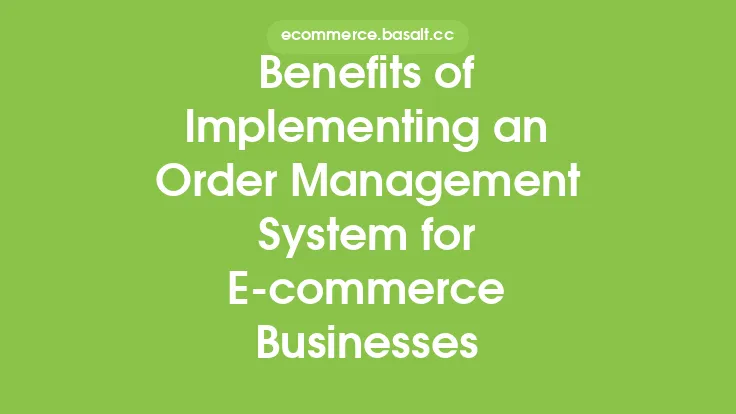Implementing a drop shipping model can be a highly effective way for e-commerce businesses to manage their order fulfillment process. This model allows businesses to sell products without having to hold any inventory, as the products are shipped directly from the supplier to the customer. One of the primary benefits of drop shipping is that it eliminates the need for businesses to invest in inventory upfront, which can be a significant cost savings. This can be especially beneficial for new businesses or those with limited resources, as it allows them to start selling products without having to make a large initial investment.
What is Drop Shipping?
Drop shipping is a retail fulfillment method where a store does not keep the products it sells in stock. Instead, it purchases the products from a third-party supplier and has them shipped directly to the customer. This means that the seller does not have to handle the product directly, and the supplier is responsible for packaging and shipping the product to the customer. This model can be beneficial for businesses that want to offer a wide range of products to their customers without having to hold a large inventory.
Benefits of Drop Shipping
There are several benefits to implementing a drop shipping model. One of the main benefits is that it allows businesses to offer a wide range of products to their customers without having to hold a large inventory. This can be especially beneficial for businesses that want to offer niche or specialty products that may not be in high demand. Additionally, drop shipping eliminates the need for businesses to invest in inventory upfront, which can be a significant cost savings. This can also help businesses to avoid inventory storage and management costs, as well as the risk of inventory becoming obsolete or going to waste.
How Drop Shipping Works
The drop shipping process typically works as follows: a customer places an order on a business's website, and the business forwards the order and payment information to the supplier. The supplier then packages and ships the product directly to the customer. The business never has to handle the product directly, and the supplier is responsible for ensuring that the product is delivered to the customer in a timely and efficient manner. This model can be beneficial for businesses that want to focus on marketing and sales, rather than inventory management and fulfillment.
Advantages of Drop Shipping for E-commerce Businesses
There are several advantages to using a drop shipping model for e-commerce businesses. One of the main advantages is that it allows businesses to start selling products quickly and easily, without having to invest in inventory upfront. This can be especially beneficial for new businesses or those with limited resources. Additionally, drop shipping can help businesses to avoid inventory storage and management costs, as well as the risk of inventory becoming obsolete or going to waste. This model can also help businesses to offer a wide range of products to their customers, without having to hold a large inventory.
Choosing the Right Supplier
When implementing a drop shipping model, it is essential to choose the right supplier. The supplier should be reliable, efficient, and able to provide high-quality products. Businesses should research potential suppliers thoroughly, and read reviews from other customers to ensure that they are choosing a reputable and trustworthy supplier. Additionally, businesses should ensure that the supplier is able to provide products that meet their quality standards, and that they are able to communicate effectively with the supplier to ensure that orders are fulfilled correctly.
Managing Customer Expectations
When using a drop shipping model, it is essential to manage customer expectations effectively. Businesses should ensure that customers are aware of the shipping times and costs associated with their products, and that they are kept informed of the status of their orders. This can be done through regular email updates, or through a tracking system that allows customers to track the status of their orders. Additionally, businesses should ensure that customers are aware of any potential delays or issues with their orders, and that they are provided with a clear and efficient returns process.
Common Challenges of Drop Shipping
While drop shipping can be a highly effective way for e-commerce businesses to manage their order fulfillment process, there are several common challenges that businesses may face. One of the main challenges is ensuring that suppliers are reliable and efficient, and that products are delivered to customers in a timely and efficient manner. Additionally, businesses may face challenges in managing customer expectations, and in ensuring that customers are aware of the shipping times and costs associated with their products. Businesses may also face challenges in handling returns and refunds, and in ensuring that customers are provided with a clear and efficient returns process.
Best Practices for Implementing a Drop Shipping Model
There are several best practices that businesses can follow when implementing a drop shipping model. One of the main best practices is to choose a reliable and efficient supplier, and to ensure that the supplier is able to provide high-quality products. Businesses should also ensure that they are able to communicate effectively with the supplier, and that they are able to manage customer expectations effectively. Additionally, businesses should ensure that they have a clear and efficient returns process in place, and that customers are aware of the shipping times and costs associated with their products. By following these best practices, businesses can help to ensure that their drop shipping model is successful, and that customers are provided with a high level of service and satisfaction.





